This chapter described file manipulation in Linux. We started with common file operations. We explained how to we can copy files in Linux with cp and how we can move or rename files with mv. Next, we discussed how we can remove files and directories with rm and how we can create shortcuts under Linux with symbolic links by using the ln -s command.
In the second part of this chapter, we discussed archiving. While there are many different tools that allow archiving, we focused on the most commonly used one in Linux: tar. We showed you how to create and extract archives, both in the current working directory and to somewhere else on the filesystem. We described that both files and whole directories can be archived by tar, and that we can see what's inside a tarball without actually extracting it by using the -t option.
We ended this chapter with finding files using file and locate. We explained that locate is a simple command that is useful under certain circumstances, while find is a more complicated but very powerful command that can provide great benefits to those who master it.
The following commands were introduced in this chapter: cp, rm, mv, ln, tar, locate, and find.
